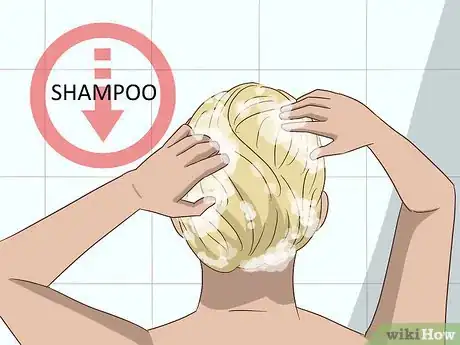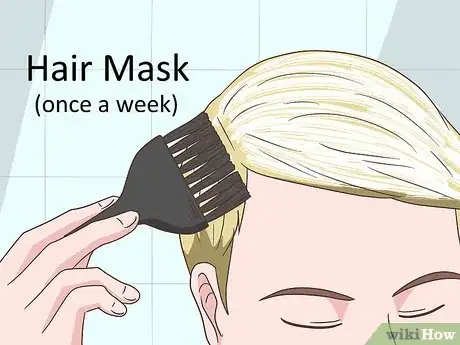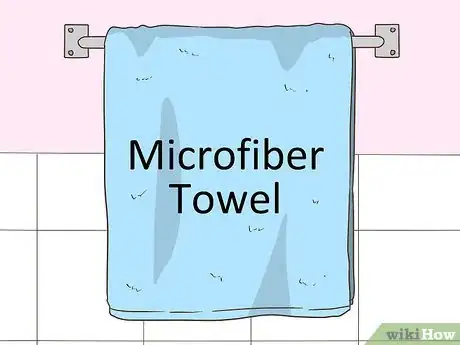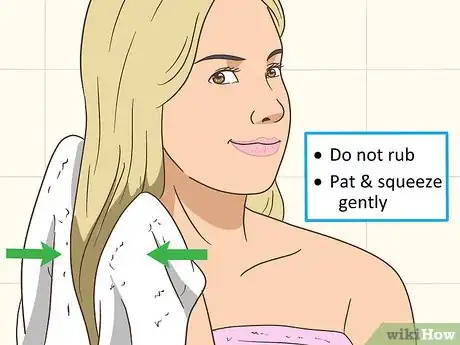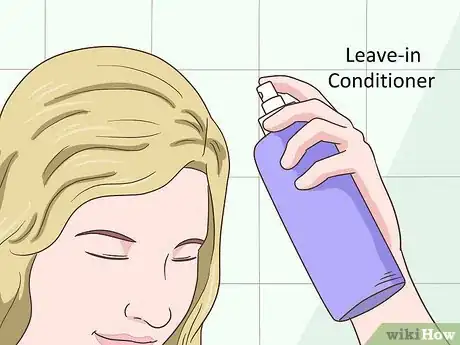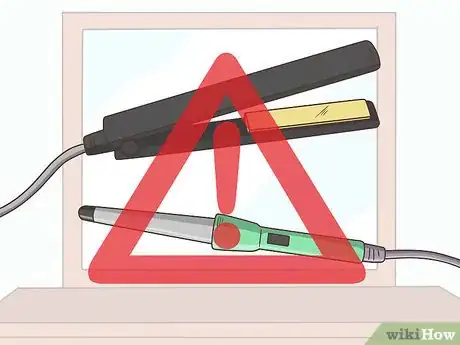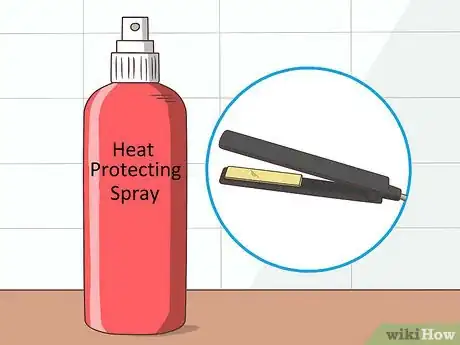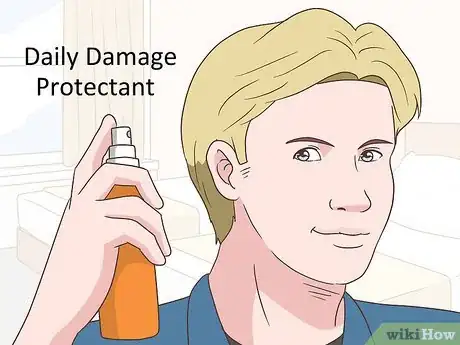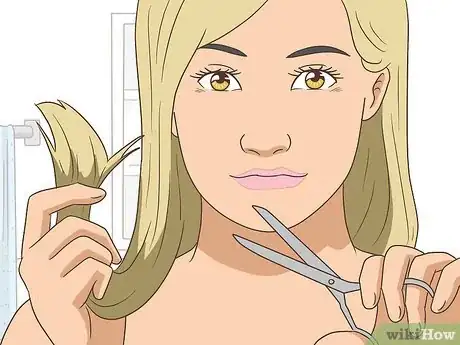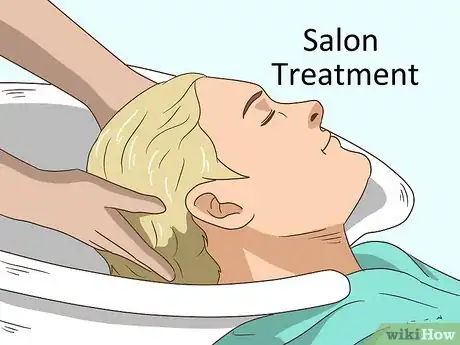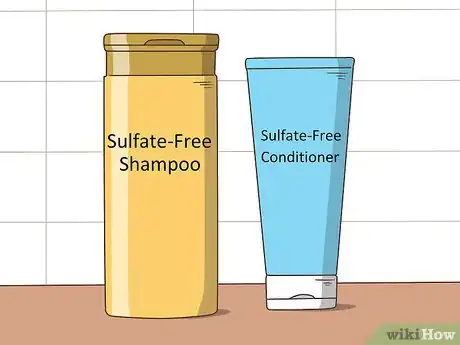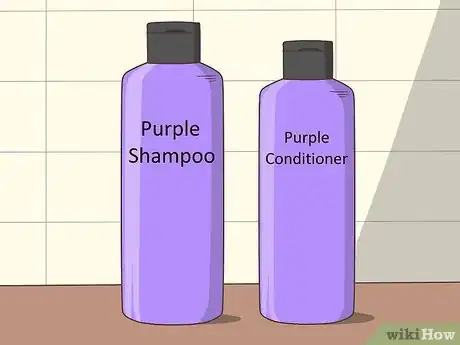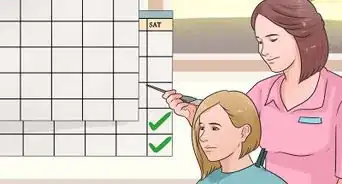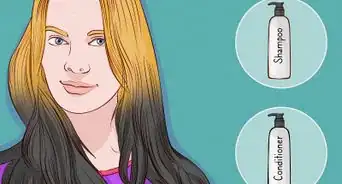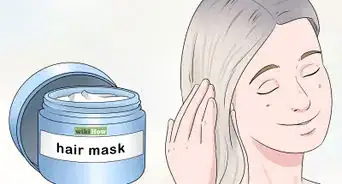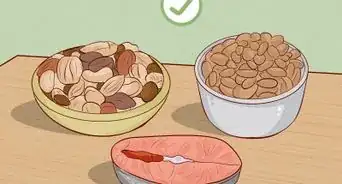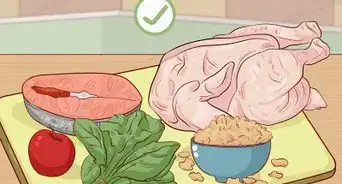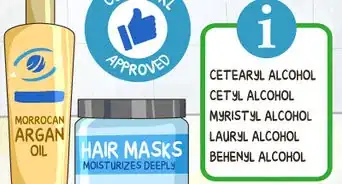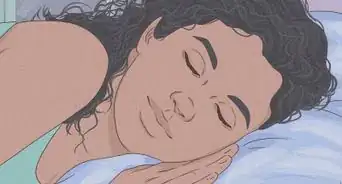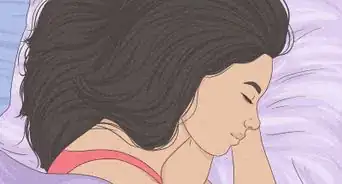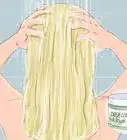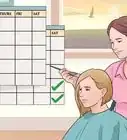This article was co-authored by Bianca Cox. Bianca Cox is a Hair Stylist, Licensed Cosmetologist, Owner of The Hair Throne, and Co-Owner of Bianchi Salon. Her salons pride themselves on their modernity, individuality, art, and professional services. You can check out The Hair Throne and more of Bianca's hairstyling on Instagram @hairthrone and on her personal Instagram @biancajcox.
There are 14 references cited in this article, which can be found at the bottom of the page.
This article has been viewed 76,799 times.
Unfortunately, bleaching is one of the most damaging things you can do to your hair. While you can't reverse the damage, there are a lot of things you can do to combat it. There are ways to add moisture to your dry, bleached hair to help it appear healthy and shiny. You must have patience and be willing to put time into your hair care if you choose to go on this hair-changing adventure.
Steps
Washing Bleached Hair
-
1Shampoo less frequently. Shampoos are designed to remove dirt and oil from the hair, but they can also strip your hair’s natural cuticle. Bleach does the same thing, so shampooing every day just layers damage.[1]
- Wash your hair every three to four days, especially in the first few weeks.
- Buy a gentle dry shampoo to spray on your roots to stretch the time you can go between washes.
-
2Do a hair mask once a week. Once a week, apply a hair mask to the entire head and comb through to distribute evenly. Leave on as directed.[2]
- All masks differ. Look for a mask for color-treated, damaged or dry hair and follow the directions for use.
- You can also use a deep conditioning treatment.
- You can make hair masks at home to save money. From avocados to tea, there are lots of things around your house that double as hair moisturizers. Learn how to Make a Hair Mask.[3]
Advertisement -
3Get a microfiber towel. Microfiber towels absorb a lot more moisture than standard cotton towels. This means you’ll be subjecting your hair to far less heat through blow drying.[4]
- These towels also prevent frizziness, which is a big problem with bleach-damaged hair.
-
4Dry your hair gently. When you're drying your hair, don’t rub your hair with your towel. The friction will cause frizz. Instead, pat and squeeze the hair gently.[5]
-
5Comb your hair gently. When your hair is brittle from bleaching, it’s important to think about how rough you can be with your hair even with simple things like combing.
- Using a wide-tooth comb, start combing at your ends and work your way up to the roots.
Styling Bleached Hair
-
1Use a leave-in conditioner. Conditioning bleached hair is the most important thing you can do to restore softness. A leave-in conditioner is an important addition to your routine.
- Look for products that contain ceramides. Ceramides are an important, natural lipid that are stripped from the hair during the bleaching process. Color-treated hair absorbs and retains these oils better than natural hair, because it’s replenishing what your hair is missing.
-
2Avoid hot hair styling tools. Straighteners and curling irons are hard on healthy hair. Do not use on bleached hair if possible.[6]
-
3Use heat-protecting hair products. If you must use hot styling tools, use hair products that protect against damage caused by high temperatures.[7]
- There are heat protecting sprays, mists, creams, and gels. Find what works best for you based on how you style your hair and what’s in your price range.
Protecting your Hair
-
1Avoid too much sun exposure. The sun not only dries your hair out, but it can also strip your hair of its color. Wear a hat when you’ll be in direct sunlight for longs periods of time to avoid damage from sun rays.[8]
-
2Use hair oil. Hair oil replaces the oils in your hair that bleaching has stripped away.[9]
- Use oil in your hair before showering to fill in the “gaps” in your hair created by missing oils. This protects against the damage of shampooing.[10]
- Use oil in your hair after showering to do the same thing. It makes the hair appear soft and shiny.
- After the shower, use oil sparingly. Part your hair into a top and bottom section. For fine hair, use one drop of oil per section, for thicker hair add a drop as needed. Coarse hair can need up to five drops.
-
3Use daily damage protectants. Hair damage isn’t all self-inflicted. Every day, we deal with things that damage hair, and they are unfortunately unavoidable. Things like pollution, UVA/UVB rays and even your A/C and heater.[11]
- Most hair protectants are for heat. Look for products that protect against heat, sun, and weather. Since your hair is already rough, look for a product that also repairs damage.[12]
-
4Trim your ends. Split ends are almost guaranteed when bleaching your hair. If left unattended, a split end can split all the way up the hair shaft, making your hair look and feel straw-like. The best way to avoid further damage created by split ends is to have your hair trimmed every 4 to 6 weeks.[13]
- To save yourself money between salon visits, you can learn to Cut Your Own Hair.[14]
- This is a good option for small trims between salon visits. Continue to consult a professional at least every six months.
-
5Get a salon treatment. If you can afford it, hair salons offer deep moisture or gloss treatments to keep hair soft and frizz to a minimum.
Maintaining Your Color
-
1Go sulfate-free. Sulfate-free hair systems are especially important for blondes. Blonde color has the tendency to turn brassy, and choosing a sulfate-free shampoo & conditioner is the easiest step toward avoiding that.[15]
-
2Get purple products. An important aspect of maintaining your ideal blonde color is having purple shampoo and conditioner on hand.[16]
- These products act as a toner by depositing purple color into your hair to neutralize any hair turned brassy and give your blonde a more natural look.[17]
- These products can also dry out your hair, so limit use to once or twice a week.
-
3Touch up your roots often. Because your head emits heat, it changes the way bleach develops on the hair closest to your scalp. Regular touch-ups also ensure an even color throughout your hair.[18]
- When your darker hair starts growing in, don’t re-bleach your whole head of hair. Every time you bleach your hair, you are adding to the damage. Minimize this by only bleaching your newly grown, healthy roots.[19]
Community Q&A
-
QuestionI've got dark roots coming through. I usually get my hair done professionally, but I just need my roots colored. What do I use?
 Community AnswerYou can get root touch up dyes from the supermarket. These work really well.
Community AnswerYou can get root touch up dyes from the supermarket. These work really well.
References
- ↑ http://www.byrdie.com/bleached-hair-care-tips/slide7
- ↑ http://www.byrdie.com/bleached-hair-care-tips/slide7
- ↑ http://www.rd.com/health/beauty/home-remedies-for-dry-damaged-hair/
- ↑ http://www.marieclaire.com/beauty/hair/a11638/microfiber-hair-towel-review/
- ↑ http://www.xojane.com/beauty/how-to-avoid-damaged-bleached-hair
- ↑ http://www.xojane.com/beauty/how-to-avoid-damaged-bleached-hair
- ↑ http://www.byrdie.com/bleached-hair-care-tips/slide7
- ↑ http://www.teenvogue.com/story/spf-hair-products
- ↑ http://www.byrdie.com/bleached-hair-care-tips/slide7
- ↑ http://www.forbes.com/sites/celiashatzman/2014/10/15/5-reasons-you-should-be-using-hair-oils/#56174bf8cbec
- ↑ http://www.philipkingsley.com/hair-guide/chemical-hair-processing-and-colouring/bleaching-your-hair/
- ↑ https://www.bustle.com/articles/121071-the-one-thing-to-do-for-your-hair-every-day-photos
- ↑ http://www.goodhousekeeping.com/beauty/hair/a32446/blonde-hair-care-mistakes/
- ↑ http://www.instyle.com/news/how-trim-your-own-hair
- ↑ http://www.naturallycurly.com/curlreading/hair_color/this-is-why-bleached-hair-turns-orange-and-how-to-stop-it-bi/
- ↑ http://www.allure.com/story/purple-products-for-blonde-hair
- ↑ https://bellatory.com/hair/DIY-Hair-What-is-Toner-and-How-Does-it-Work
- ↑ http://www.goodhousekeeping.com/beauty/hair/a32446/blonde-hair-care-mistakes/
- ↑ https://www.washingtonpost.com/news/speaking-of-science/wp/2015/01/23/why-bleaching-wrecks-your-hair-and-how-to-make-it-better/?utm_term=.b2bd138e6dfc
About This Article
If you have bleached hair, you'll want to take extra care to keep your locks healthy. Since shampoo can strip your hair’s natural oils, only wash your hair every 3 to 4 days. When washing, use sulfate-free shampoos and conditioners so your bleached hair doesn't turn brassy. Once a week, apply a hair mask to add more moisture to your hair. Try to find one that’s specifically designed for color-treated, damaged, or dry hair. When you’re ready to style your hair, use a leave-in conditioner to restore softness and try to avoid hot hair styling tools, like straighteners and curling irons. If you have to use hot styling tools, apply a heat-protecting hair product first to protect your locks. To keep your hair from getting sunburned, wear a hat when you’re in direct sunlight for long stretches of time. To learn how to touch up your roots when you have bleached hair, keep reading!
